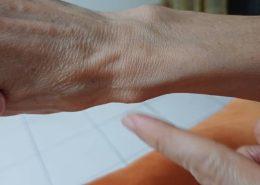I am 63 y/o female. I got this bump on my wrist for more than 2 weeks and it is very painful, feels hard and bony… is it bone spur? do I need to do x-ray?
Based on your description of the incident and the symptoms you're experiencing, there are several possibilities to consider. While I cannot view images, I can guide you on the understanding and management of toe injuries, particularly focusing on the likelihood of a toe fracture. Clinical Overview WRead more
Based on your description of the incident and the symptoms you’re experiencing, there are several possibilities to consider. While I cannot view images, I can guide you on the understanding and management of toe injuries, particularly focusing on the likelihood of a toe fracture.
Clinical Overview
When you sustained a fall onto your toe, it could have resulted in various injuries, including a toe fracture or a soft tissue injury such as a sprain. The symptoms you describe—bruising, stiffness, and pain—are quite common following either injury. Here are some key considerations:
1. Toe Fracture:
– Given that you have some ability to move the toe and the pain intensity is moderate, this could potentially indicate a nondisplaced fracture, where the bone might have a minor crack but remains in alignment. Bruising is typical with bone injuries, as well as sprains.
– Important indicators of a fracture might include pinpoint tenderness directly over the bone, visible deformity, or when you experience shooting pain upon engaging in specific movements.
2. Soft Tissue Injury (Sprain):
– Sprains involve injury to the ligaments and might present similarly, but tend to allow more movement than a fracture would, assuming they are not severe.
Management and Recommendations
1. Rest and Protection:
– Avoid activities that stress the toe or exacerbate the pain. Give yourself a few days to rest and avoid unnecessary walking.
2. Ice and Elevation:
– Continue applying ice intermittently (15-20 minutes every hour) to reduce swelling.
– Elevate the foot to decrease swelling and provide relief against gravity-induced edema.
3. Pain Management:
– Over-the-counter NSAIDs (e.g., ibuprofen, naproxen) or acetaminophen can be taken to help manage pain and inflammation.
4. Protection:
– If available, use buddy taping to stabilize the toe by taping it to an adjacent toe with a soft cushion between them to prevent skin irritation.
– Consider wearing a stiff-soled shoe to minimize toe movement further and offer protection while walking.
When to Seek Further Medical Attention
Given the persistent pain and restricted movement, it would be prudent to seek a professional evaluation if:
– There is significant swelling or persistent bruising.
– You experience increased pain or any loss of sensation or color changes in the toe.
– You cannot bear any weight on the toe.
– The symptoms do not improve with self-care after a few days.
A clinical examination and potentially an X-ray would confirm whether there is a fracture and determine the treatment plan. Healing and proper management are crucial to prevent long-term complications such as arthritis or chronic pain.
Prevention and Future Considerations
Once healed, consider engaging in preventive measures such as proper warm-up exercises, possibly reviewing floor surfaces for traction, and ensuring adequate support for activities like pole dancing. This can help minimize repetition injuries or acute incidents.
Overall, the primary goal is to ensure proper healing while mitigating pain and enhancing functional recovery through careful monitoring and appropriate intervention.
See less


In evaluating a painful, hard bump on the wrist, especially in a 63-year-old female, several possibilities could be considered, including a bone spur, ganglion cyst, or other bony or soft tissue abnormalities. Here’s a structured approach to assess and manage your condition: Differential Diagnosis 1Read more
In evaluating a painful, hard bump on the wrist, especially in a 63-year-old female, several possibilities could be considered, including a bone spur, ganglion cyst, or other bony or soft tissue abnormalities. Here’s a structured approach to assess and manage your condition:
Differential Diagnosis
1. Bone Spur (Osteophyte): These are bony projections that can develop along the edges of bones, often due to arthritis or joint degeneration. They can cause pain if they press on nerves or other structures.
2. Ganglion Cyst: Although typically softer, these fluid-filled sacs can sometimes feel firm and cause discomfort, especially if they press on nearby nerves.
3. Arthritis: Osteoarthritis or rheumatoid arthritis can lead to joint deformities or nodules that might feel hard and painful.
4. Other Bony Lesions: Less commonly, other bony growths or tumors could present similarly.
Recommended Evaluation
– Clinical Examination: A thorough physical examination by a healthcare professional can help differentiate between these possibilities based on the location, consistency, and mobility of the bump.
– Imaging:
– X-ray: This is a reasonable first step to evaluate bony structures and identify any bone spurs, fractures, or significant arthritic changes.
– Ultrasound or MRI: If the X-ray is inconclusive, these imaging modalities can provide detailed information about soft tissue structures, such as ganglion cysts or tendon abnormalities.
Management Considerations
– Conservative Treatment: Depending on the diagnosis, initial management might include rest, ice application, and nonsteroidal anti-inflammatory drugs (NSAIDs) to reduce pain and inflammation.
– Referral to Specialist: If the diagnosis is uncertain or if conservative management fails, referral to an orthopedic specialist or a rheumatologist might be necessary for further evaluation and treatment.
– Surgical Intervention: In cases where a bone spur or other lesion is causing significant pain or functional impairment, surgical removal might be considered.
Actionable Steps
1. Schedule an Appointment: See your primary care physician or a specialist for an evaluation.
2. Imaging: Discuss the need for an X-ray or other imaging studies to clarify the diagnosis.
3. Follow Medical Advice: Based on the findings, adhere to the recommended treatment plan, which may include medication, physical therapy, or further specialist referral.
Given your age and symptoms, it is important to address this promptly to prevent further complications and to ensure appropriate management.
See less